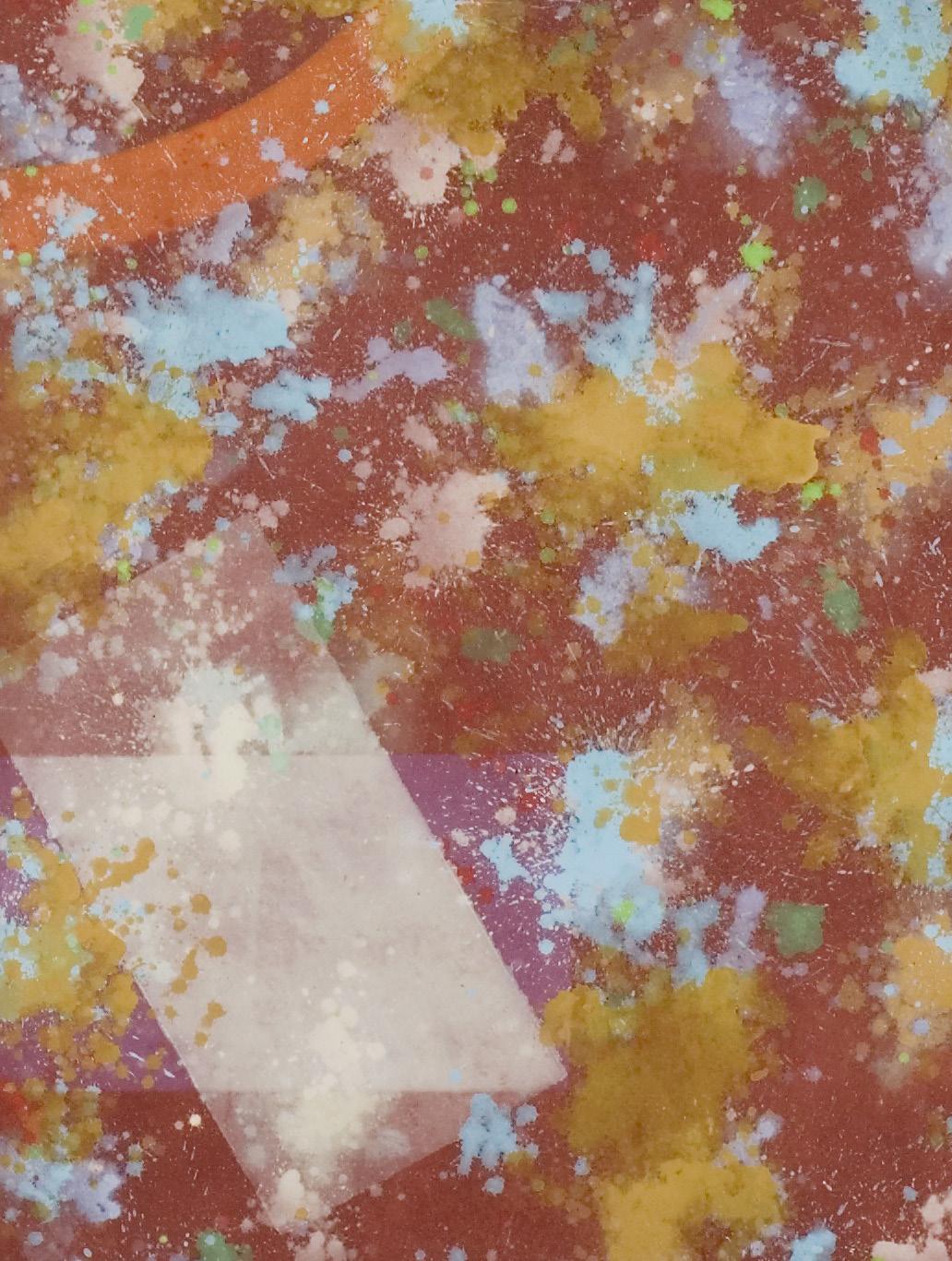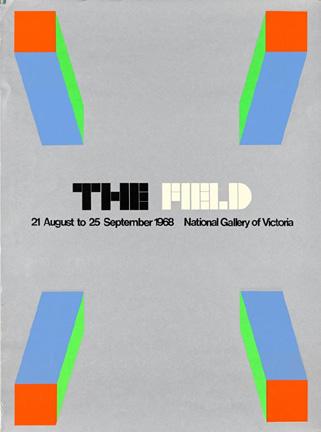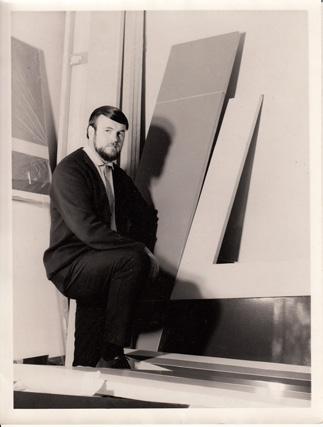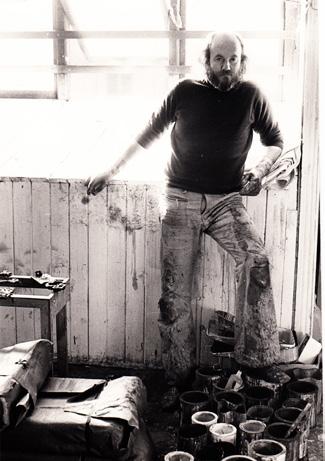
8 minute read
Sydney Ball: The Stain paintings
By Patrick McCaughey
Sydney Ball arrived on the Australian art scene with a bang in the mid 1960s with his series Cantos. They were bold and memorable and took Australian painting in a new direction. Here was a painter who thought in colour and saw it as the subject of his art, not just an agent of form. The range of his colour spoke to his originality, from highkeyed sunbursts of light to a melodious set of lower tones. The format of circle and square framed in bars of colour was a firm and effective.
Had he wanted to, he could have had a lifetime painting the Cantos, become an antipodean Josef Albers. But his character as an artist would not permit that. To keep himself moving forward in his exploration of colour, he had to vary the formats. We had the architectural and decorative richness of the Persian series, followed by the Modular paintings where colour became substance in solid blocks and panels – the constructivism of colour.
But nothing quite prepared his critics or his admirers for the surging change of the Stain paintings in the 1970s. At a stroke Ball broke free of being typecast as a ‘sixties artist’. The new paintings had an expressive freedom, a sense of release that stood on end the tight-fisted manners of the 1960s. They were undoctrinaire. Ball discovered the volatility of colour as well as its iconic luminosity, which the earlier paintings had espoused so handsomely. He now saw colour as the inherently unstable force in painting, generating its electricity and charge. The change came about for many reasons. Ball was concerned not to paint himself into a cul-de-sac. The late 1960s and early 1970s brought increasing outcries that “painting was dead”, that it was finished as a medium for new and serious art. Minimalism and the variety of post-minimalist modes – from installations and informal sculpture to video and performance, conceptual art, documentation and photography – were now the acceptable advanced forms of art. It was a testing time for painters. Their commitment to painting was questioned and challenged.
What sustained Ball and took him into the new direction of the Stain paintings was his knowledge and love of earlier painting. His admiration for Tintoretto, especially the Scuola di San Rocco cycle or the immense paintings done for his parish church in Venice, the Madonna dell’ Orto, is one of the surprises of his taste. The scattering of incidents across large expanses of canvas in Tintoretto, without dissipating their intensity of feeling, moved Ball as man and artist and inspired in part the scale of the Stain paintings.
His admiration for the modernist tradition, from Monet to Jackson Pollock and Mark Rothko, has never wavered nor has his delight in Cézanne and his descendants in the School of Paris. I can vouch for Ball’s concentrated looking at paintings from numerous visits around New York galleries and museums and from trips we did together to Buffalo to see the Clyfford Stills at the Albright-Knox Art Gallery, or to the Barnes Foundation in its original iteration in Philadelphia. These experiences consistently enriched his sensibility and strengthened his faith in his own art.

Sydney Ball, Jackson Summer (detail), 1973, acrylic on cotton duck, 218 x 381 cm RIGHT: Sydney Ball in his studio
Looking at the Stain paintings forty years on, what strikes me is how different they look from each other today, how much variety there is from canvas to canvas. Each painting is a fresh encounter, as though Ball explicitly set out never to repeat himself. (They looked more homogeneous in the 1970s for reasons I find hard to pin down.) He varies his favoured colour propositions – blue and gold, red and green – with slashes of earth tones and royal purple.
If you work in such a spontaneous, improvisatory way, you risk looking arbitrary, one slash of colour after another. Manifestly that’s not how we read the Stain paintings today. They seem so purposeful, brimming with conviction and feeling. What refutes the charge of arbitrariness is the constancy of the rhythms from painting to painting. In almost all of them forms rise from the bottom edge or cascade down from the top, meeting and making for the turbulent, energetic centre.
I notice too how adamantly the paintings read from left to right. Of course, all western paintings do, from Giotto to Cy Twombly. Ball makes the rhythm such an explicit part of abstractions that it gives the paintings aquasi-narrative quality as though we are being swept along by the action of colour on colour, ragged stain on ragged stain. The Stain paintings are one of the triumphs of Australian art in the 1970s and have been somewhat overlooked in the accounts of that difficult and puzzling decade. How good it is to see them again and what miracles of vitality and enterprise they are. Like all major works of art, they renew the senses and the soul.

Sydney Ball in his studio
Upcoming Exhibition: Sydney Ball: 1963-1973 Works from the estate / Sydney / 30.7.2020
This foreword was written by Patrick McCaughey in 2013 and was originally published in the book Sydney Ball: The Stain Paintings 1971-80.
Patrick McCaughey is a former director of the National Gallery of Victoria, Melbourne; the Wadsworth Atheneum, Hartford, Connecticut; and the Yale Centre for British Art, New Haven, Connecticut.
He has published widely on Australian art including a monograph on Fred Williams, and writes for a number of journals including the Times Literary Supplement and the Yale Review. His friendship with Sydney Ball spanned over four decades.
Sydney Ball: Timeline 1960-1980
1960-62 — Ball studies part time at the South Australian Institute, Adelaide, taught painting by James Cant. Ball decides to study at the Art Students League of New York, he sets sail for New York in 1962.
1963 — Ball commences full-time studies at Art Students League studying painting under Theodore Stamos (one of the Irascible Eighteen). Ball visits galleries and museums on his afternoons off, sees a major survey exhibition by Mark Rothko, whom he meets later that year. He begins the Band series.
1964 —Ball is invited to hold a solo exhibition at the Westerly Gallery, West 56th Street, New York, and the show is reviewed by Donald Judd. He participates in a group show at Westerly Gallery alongside Carl Andre and other students of Robert Motherwell at Hunter College, and is awarded the Ford Foundation scholarship. He develops the first Canto series works, the title of which is based on the poems by Ezra Pound. Ball meets other members of the Irascible Eighteen, including Willem de Kooning and Robert Motherwell, and is invited to Rothko’s house for Thanksgiving dinner. He travels to Jackson Pollock’s studio and meets Lee Krasner. One of his Canto paintings is sold to the Aldrich Museum of Art – his first museum sale.
1965 —Ball returns to Australia via Japan. His first solo show, the Canto series, is shown at the Museum of Modern Art Australia arranged by John Reed. Reed purchases two works from the show and one other work sells, however the show is not reviewed favourably. In October, Ball is unanimously awarded the Mirror-Warratah Invitation Art prize, and is appointed Lecturer at the South Australian School of Art. 1966 — Ball exhibits at the Watters Gallery in Sydney. Newcastle Art Gallery acquires Canto XIX, 1966 There is keen support from Elwyn Lynn and Patrick McCaughey. The National Gallery of Victoria acquires Canto XXI. The Persian series begins.

1967 — Ball begins the Modular series. The Persian series is widely exhibited and shown in group show Engine in Sydney, with Col Jordan and Ken Reinhard.
1968 —Ball wins the Georges Invitation Art Prize, judged by Clement Greenberg, and is included in The Field at the newly opened NGV (he also designs the poster).

1969 —The Modular series is shown at Bonython Galleries, Adelaide and Sydney. Ball returns to New York, and begins studies for his new Link series. 1970 — Ball’s studio is destroyed by fire – including all paints and materials. He meets up with Greenberg again and is introduced to Ken Noland, Jules Olitski and Jack Bush. Travels the East Coast of America with Lynn and McCaughey. Following Rothko’s death, Ball is asked to clean the studio, where he had been working and assembling Rothko’s Menil Chapel commission.

1971 — Ball begins the Stain series, and continues to work in Rothko’s studio preparing catalogues for touring shows. Commits to an exhibition of the Link works in Adelaide, returns home to Australia, via Japan.
1972-75 — The Stain series is shown at Bonython Gallery, Sydney to great acclaim, and further successes in subsequent shows in Melbourne, Sydney, Canberra and Adelaide. Ball is included in Ten Australians ABC-TV documentary, with an international tour of Paris, Stuttgart, Milan, Florence, Rome and Venice. Ball, who now lives in Sydney is appointed Senior Lecturer in Art, City Art Institute, Sydney College of Advanced Education. Survey exhibition held at Newcastle City Art Gallery.
1976 — Ball buys 10 hectares of land at Glenorie to build a home and studio with partner Lynne Eastaway. A survey exhibition of his Stain series works is held at St John’s Cathedral, Brisbane.

1977-80 — Works from the highly acclaimed Stain series are acquired by James Mollison for the National Gallery, Canberra.










